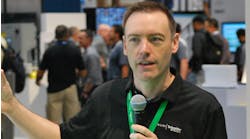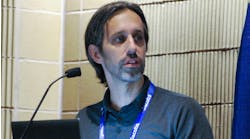PFAS is arguably the most talked-about topic in the water space right now. In fact, more than 20 of the technical sessions and presentations at this week’s WEFTEC 2024 addressed per- and polyfluoroalkyl substances (PFAS) in some fashion, including one on Wednesday morning focused on PFAS management for industrial dischargers, where speakers from three distinct industries took the stage to discuss PFAS management.
Managing PFAS in the surface finishing industry
Jeff Hannapel (pictured), who is the vice president of regulatory affairs at The Policy Group, kicked things off speaking on behalf of the National Association of Surface Finishers (NASF).
Hannapel said the surfacing finishing and plating industry had long used perfluorooctane sulfonate acid (PFOS)-based fume suppressants to reduce emissions of hexavalent chromium before transitioning to PFAS-based fume suppressants in September of 2015. The industry is now working on developing PFAS-free fume suppressants, according to Hannapel.
“We’re looking at moving to trivalent chromium processes where we wouldn’t need to use the fume suppressant,” he said. “But that doesn’t mean we don’t have this legacy [PFAS] issue.”
Hannapel went on to say that the metal finishing industry is now facing Effluent Limitation Guidelines (ELG) for PFAS. According to the EPA, ELGs are national, technology-based regulations developed to control industrial wastewater discharges to surface waters and into publicly owned treatment works.
“One thing to keep in mind is that we’re not first in line. First in line are the chemical manufacturers,” Hannapel said. “Whatever happens in that rule is likely to happen in ours.”
The NASF has a PFAS resource center on its website to provide members with technical information. “It’s a good resource for the public, for regulators and the supply chain,” Hannapel said, adding that the organization has also developed a PFAS sampling analysis plan for its members.
Hannapel concluded by describing how the NASF has been working with automotive original equipment manufacturers (OEMs) via a workgroup to transition from hexavalent chromium to trivalent chromium.
“What we’re doing is getting the OEMs to say, ‘we’ll take it, we’ll do it,’ and we’re working on developing specifications on that so that we can switch to trivalent. The switch to trivalent means there’s no hexavalent chromium emissions, which is good, and we wouldn’t need to use any fume suppressants with that,” Hannapel explained. “So, one of the things we tried to do is look at this both ways from a fume suppressant standpoint and from a process [standpoint].”
A solid waste industry perspective on PFAS
John Davis, director of environmental protection at Waste Management, then took to the stage with the goal of talking in broad terms from the perspective of the solid waste/landfill industry, outlining its big picture view on what he called the “PFAS challenge.”
His first — and what he said was the most important — point of the presentation, was emphasizing that the industry supports the goal of managing PFAS in the environment.
“From an industry standpoint, it isn’t necessarily just the leachate going out the door. We need to focus on the waste coming in, in addition to the waste going out the door,” Davis said. “The waste that’s entering the landfill obviously contains PFAS, regardless of the source — if it’s industrial sources, biosolids or other industries. But also, a lot of consumer products are very, very high in PFAS concentration, PFAS mass. So, the industry as a whole is implementing and volunteering restrictions on the volume of waste that they accept as PFAS-containing, and also putting limitations on the concentration of PFAS in the waste, regardless of volume.
“So that’s one way that we can directly control or directly impact the leachate, or the quality of the leachate, that’s heading out our door. But at the same time, that effort has to be balanced with the service that we provide to society. As the EPA recognizes, the landfill industry is one of only a few outlets that are environmentally sound in the disposal of PFAS-containing waste. So that is something we want to continue into the future.”
Davis went on to acknowledge that landfills and other solid waste services are a contributor and a source of PFAS, and that his company is working with a number of different technology vendors on instances where PFAS needs to be managed and treated.
“We recognize that PFAS in the environment is not a single-industry problem, it’s not a single-industry solution. This is something that is going to be an all-hands-on-deck approach,” Davis said. “Until everyone gets on board with that approach, PFAS is really going to be a challenge into the future.”
Davis also touched on the federal regulatory landscape involving PFAS, outlining how recent regulations are affecting the landfill industry, and he outlined to the audience that the biggest regulatory challenges are taking place at the state and local levels.
“It’s a patchwork quilt out there of regulations and which states have programs and which states don’t. How far along are they? Do they have limits? Are we just monitoring?” Davis said. “And then, taking the next step down, you have local municipalities that are going out on their own and saying, ‘I want PFAS addressed in this municipality,’ and directing their wastewater treatment plans to impose limits that way. So, we’re starting to see that, as well. And the challenge that presents isn’t just necessarily to the companies that have a nationwide footprint, it’s the smaller, regional companies, as well. As you can imagine, going state to state, regulatory uncertainty—and the cost associated with regulatory uncertainty—can climb drastically.”
From a treatment perspective, several PFAS removal/destruction technologies are being utilized in the industry, according to Davis, including ion-exchange resins and reverse osmosis, along with other emerging technologies.
“Treating PFAS is, at a minimum, a two-step process,” Davis said. “Remove the PFAS from the primary waste stream and then deal with the residuals with either destruction technology or some other form of disposal.”
Davis closed by emphasizing that the sector takes seriously its role as a viable and sound outlet for PFAS disposal, and that the future of PFAS management needs to be a collaborative effort.
“Everybody is going to have to bring something to the table,” Davis said. “It’s going to involve the regulatory community, it’s going to involve our partners at wastewater treatment plants and approaching everything from a holistic standpoint.”
The Air Force and PFAS
United States Air Force veteran David Kempisty, who now serves as the director of research and development at ECT2, was the final presenter during the session. Kempisty, who served 22 years in the Air Force, focused on three key areas:
- A broad overview of the PFAS challenge from the Air Force perspective.
- The different approaches the Air Force and Department of Defense have taken to address PFAS.
- Different treatment solutions that have been implemented and evaluated by the Air Force.
Kempisty said the Air Force has been using Aqueous Film Forming Foam (AFFF) — a fire suppressant used by to fight flammable liquid fires that contains PFOS and perfluorooctanoic acid (PFOA) — for more than 50 years and that AFFF use has resulted in contamination across more than 700 different Air Force installations that have completed preliminary PFAS assessments.
“These installations are geographically dispersed and it is a challenge to manage those number of installations and different levels of contamination,” Kempisty said. “And it’s not just fire training. Other plating operations or industrial operations, structural maintenance, corrosion control — all these activities can use fluorochemistry, and using fluorochemistry, you can perhaps have yourself exposed to PFAS contamination. So, managing this as an entire enterprise without consistent federal regulations, the Air Force wants prescriptive guidance on the treatment objectives. Without that, it’s a disparate set of regulations that they have to navigate across many different states, territories, overseas environmental baseline guidance documentation… but they are ultimately trying to do this consistent, science-based approach [to PFAS management].”
Kempisty said the Air Force is transitioning from PFAS-containing AFFF to a fluorine-free foam with the hope of completing that transition by September 30, 2024. He added that the Air Force created a PFAS-related task force during the summer of 2019 that has five focus areas:
- Supporting PFAS research efforts
- Expanding public-related outreach efforts
- Understanding the impacts of PFAS on human health
- Cleanup responsibilities
- Managing and eliminating the use of PFAS-containing AFFF
From a treatment perspective, Kempisty said the Air Force is utilizing a number of technology solutions, including granular activated carbon, ion-exchange resin and foam fractionation. He then closed his presentation by outlining a real-world application on how the Air Force is managing PFAS at its installations.
A 2,000-foot-long section of concrete pipe, four feet in diameter, which had been abandoned at an Air Force installation and was filled with AFFF-impacted wastewater, was leaking into the groundwater aquifer and affecting the drinking water aquifer for the local community.
A treatment program involving granular activated carbon and an ion-exchange resin was implemented. Kempisty said the PFAS species that were the target objective were non-detectable after the treatment process.
“How did we do that? We did that through the use of a two-week treatability study up front,” Kempisty said, adding that the treatment period was six weeks for this particular project.







